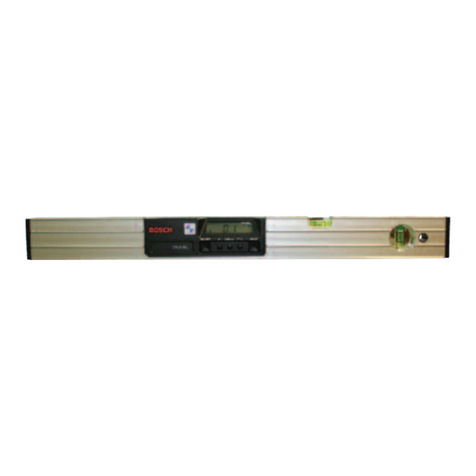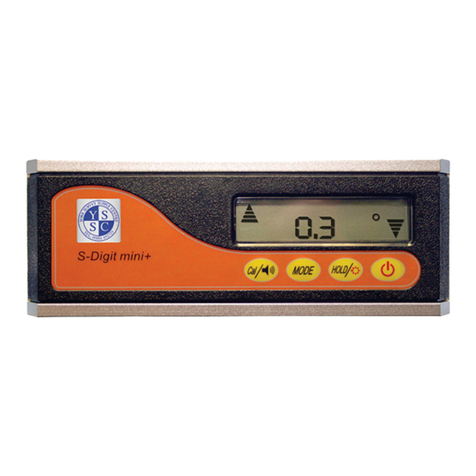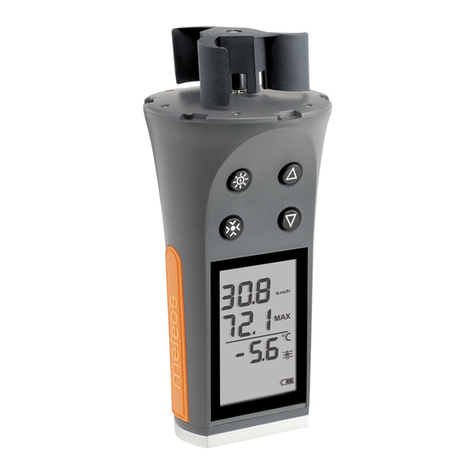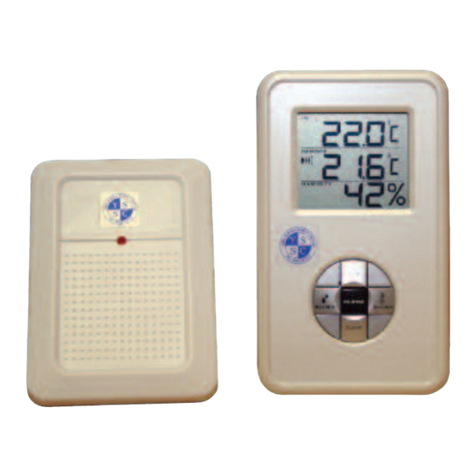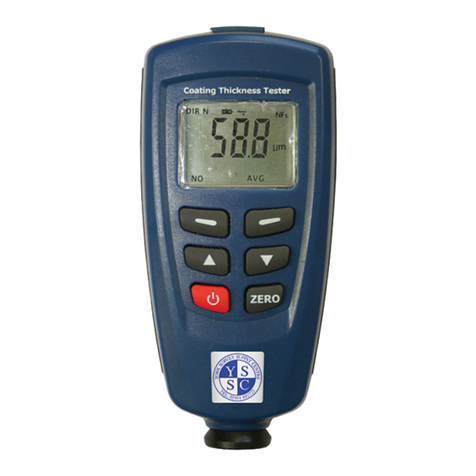© ork Survey Supply Centre 2018Ref:.. \operat98\instructions 18\343680.qxp 05-01-18
Lux Meter
I Introduction
> The digital illuminance meter is a precision instrument used to measure illuminance
( ux, Footcandles).
> It meets CIE photopic spectral response.
> The illuminance meter is compact, tough and easy to handle due to its construction.
> The light sensitive component used in the meter is a very stable, long life silicon
photo diode and spectral response filter.
II Features
> ight measuring levels ranging from: 0.1 ux ~ 0.1k ux/0.01FC ~ 0.01kFC.
> High accuracy and rapid response.
> Data-hold function for holding measuring values.
> Unit and sign display for easy reading.
> Automatic zeroing.
> Meter corrected for spectral relative efficiency.
> Correction factor need not be manually calculated for non-standard light sources.
> Short rise and fall times.
> Peak-hold function for tracing the peak signal of light.
> Capable of selecting measuring mode in ux or FC scale.
> Auto power off 30 minutes.
> Maximum and minimum measurements.
> Relative reading.
> Easy to read, large backlit display.
> USB output connect with PC.
> Auto ranging
III Specifications
> Display: 3¾ digit CD screen with high speed 40 segment bar graph.
> Measuring range: x400.0 ux, 4000 ux, 40.00 k ux and 400.0 k ux / 40.00 FC,
400.0 FC, 4000 FC and 40.00 kFC.
NOTE: 1FC = 10.76 ux, 1k ux = 1000 ux, 1kFC = 1000FC
> Over range display: CD will show “OL” symbol
> Accuracy: ±5% rdg ± 10d (<10,000 ux), ±10% rdg ± 10d (>10,000 ux)
> Repeatability: ±3%
> Sampling rate: 1.5 times/sec of analogue bar graph indication;
1.5 times/sec of digital display
> Photo detector: One silicon photo diode and spectral response filter
> Operating temperature and humidity: 0°C to 40°C (32°F to 104°F)
and 0% to 80%RH
> Storage temperature and humidity: -10°C to 50°C (14°F to 140°F)
and 0% to 70%RH
> Power source: 1x 9V battery
> Photo detector: ead length: 150cm (approx.)
> Photo detector: Dimensions: 115 x 60W x 20H (mm)
> Meter dimensions: 170 x 80W x 40H (mm)
> Weight: 390g
> Accessories: Carry case, instruction manual, battery
1. Name and Functions
(1) LCD Screen
(2) Auto-Ranging
Both ux and FC (Footcandles) have four ranges each: 400.0 ux, 4000 ux, 40.00
k ux and 400.0 k ux for the ux range and 40.00 FC, 400.0 FC, 4000 FC and 40.00
kFC for the FC range. These ranges change automatically with how much light is
exposed tot he sensor and the reading on the display indicates this.
(3) Power Button
For manual operation press the power button and the instrument will switch on. if
this clock symbol is displayed in the CD screen in the top left hand corner, press
DISABLE APO to remove this symbol and manual operation has now been selected
and auto power off has now been disabled, allowing the meter to be turned off
manually when needed. To switch the meter off, press the power button and the
instrument should turn off instantly.
(4) Disable Auto Power Off Button
For auto power off, turn the unit on by pressing the power button and if the clock
symbol is not showing on the CD screen, press the DISABLE APO button and this
clock symbol should appear on the display. This means that auto power off has now
been selected and the meter should turn off automatically after 30 minutes.
(5) Back Light Button
This button allows you to turn a blue backlight on the CD screen on/off.
(6) USB Button
This button is used to make a connection from the meter to the computer through the
USB cable. If the USB button is not pressed before the cable is placed into the USB
port and the meter and software is open, it may not connect correctly. Also, if the USB
button is pressed, but you do not want to connect the meter to the computer straight
away, the meter will stop recording and will wait to be connected. If you do not wish to
connect with the computer at the present time, but the USB button has been pressed,
the meter will have to be reset which could result in recorded data stored in the unit
being lost.
(7) MAX/MI Button
This button allows you to select maximum or minimum hold. To select maximum press
the MAX/MI once and MA U MAX will appear across the top of the CD screen. The
displayed ux/FC is the maximum value recorded since activation. For minimum, press
MAX/MI again, whilst MA U MAX is still showing and MA U MI should appear in
its place on the screen. The current value shown is the minimum value recorded since
activation.
(8) REL Button
To view the relative reading, press REL and MA U REL will appear at the top of the
screen. The relative reading shown is the difference between the first and second
reading detected by the meter. For example: If the first reading taken was 60 and the
second was 40, then the relative reading on the meter would be 20. So with every two
readings detected by the meter, the instrument will work out the difference and change
automatically.
(9) PEAK Hold Button
This button allows you to select maximum or minimum peak hold. To view the
maximum peak hold, press the PEAK button once and across the top of the CD
screen MA U PMAX will appear. The reading currently displayed on the meter is the
maximum peak in the results since the meter was activated. To select minimum peak
hold, press the PEAK button again, whilst MA U PMAX is still showing and MA U
PMI will appear. The reading displayed will be the minimum peak in the results since
the meter was activated.
(10) HOLD Button
Press HOLD to freeze a current reading on the display. Press HOLD again to release.
(11) Lux Button
To select readings in ux, press the Lux button and Lux will appear next to the value.
(12) FC Button
To select FC, press the FC button and FC will appear next to the reading on the
display. 1FC = 10.76 ux.
2. Operatin Instructions
(1) Turn the meter on using the power button.
(2) Select the desired scale, either ux or FC.
(3) Remove the protective cap from the light sensor and face the sensor into the light
source, in a horizontal position, so that the whole of the sensor is exposed to all the
light, making sure that the readings taken are accurate. Any other position could
corrupt the readings.
(4) Read the measurement on the CD screen.
(5) When the instrument is not in use, it is important that the protective cap is replaced
and the meter is switched off.
(6) Battery Check: When the battery is low, in the bottom left hand corner a battery
symbol will appear. This is an indicator to let you that the voltage in the battery is
running low and it needs to be replaced. If it is not replaced, having a low battery can
affect how well the unit will work and its efficiency will drop.
3. Maintenance
(1) The white plastic disc on the light sensor should be cleaned when necessary with a
damp cloth, as any dirt on the sensor could corrupt the readings.
(2) The instrument should not be stored where the temperature and humidity is
excessively high. Any moisture that gets inside the instrument could damage the
components inside the meter and stop the instrument from operating correctly.
(3) To ensure that the meter is working correctly it is recommended to have the meter
calibrated annually.
4. Recommended Illumination
5. Installin the Software
(1) Start Windows
(2) Insert the CD into the CD drive
(3) if the InstallShield Wizard does not appear automatically, go to START at the
bottom of the desktop, then Run... then browse for 1309 (D:) which is the name of the
software you wish to install.
(4) By clicking on 1309 (D:) it will open up the files stored within the CD. Open the
SETUP file and follow the instructions to install the software.
(5) Once installation is complete, you will see a red recycling symbol appear on the
desktop with DT 1309 underneath it. This means that the installation was successful.
If you have the SL-8851 or SL8852 sound level meter, installing the software is
not necessary because the hardware stored in these meters is the same as the
hardware stored in the LX-1309.
If you do not have these products, it is necessary to install the hardware as the
software will not be ready for use with it. Do not remove the CD even though
installation is complete because it is needed for installing the hardware.
6. Installin the Hardware
(1) With the CD for installing the software still in the CD drive, turn the meter on and
plug the meter into the USB port with the USB cable supplied with the meter.
(2) At the bottom of the desktop, on the right hand side a message will appear
indicating that the computer has detected new hardware in the USB port. If the
Found ew Hardware Wizard window does not appear, double click on this message
and this should open the Hardware Wizard window for you.
(3) In this window it will ask you if you would like to connect to Windows Update to
search for software. Click ‘ o, not this time’ because you already have the software
installed and the software disc in the CD drive, then press next. Follow the instructions
to install the hardware. In the last window it should say CP2101 USB Composite
Device, this means that the first hardware driver has been installed.
(4) Click Finish and you will notice that the same Found ew Hardware Wizard
window will appear on the desktop. Do not press CA CEL, as this window is for
installing the second hardware driver. Install this driver in the same way as the previous
driver and in the last window instead of CP2101 USB Composite Device, it should say
CP2102 USB to UART Bridge Controller. Click FI ISH and both hardware drivers
should be installed, allowing the software to be used with the device.
If you wish to un-install the drivers, in add or remove programs (which can be found in
the control panel) you will not find two separate drivers with the names CP2101 USB
Composite Device and CP2102 USB to UART Bridge Controller, you will find one
driver called CP210x USB to UART Bridge Controller. This is because both drivers,
when stored to the computer, are stored and saved together, so by un-installing this
you are, in fact, un-installing both the drivers.
7. Usin the Software
(1) Open the software and connect the meter to the computer with the USB cable.
(2) Turn the meter on and press the USB button on the meter to allow the meter to be
connected to the software.
(3) On the software you will see an image of the lux meter that has the words o
Connection on the CD screen. To create a connection, go to Com Port(C) and on
the drop down menu select Com3(M).
If the connection is successful, the lux meter image on the software should now be
displaying the same information as the actual meter. In some cases this com port will
not work and Com4(4) will have to be selected instead, but the meter will still work with
the software exactly the same as it would with Com3(M) selected. If this is also
unsuccessful, try selecting one of the other com ports until a connection is made.
8. Recordin Data
To record data using the software, follow the instructions for 7. Using the Software
then go to Real Time(R) at the top of the screen and select Run(R) to start recording
data on the line graph or press the lightning bolt symbol on the tool bar.
Once Run(R) has been activated, a red line will appear on the graph and start to move
with every reading detected by the meter. To change the type of graph from a line
graph, go to Graph(G) and the graph can be changed from Line(L) to Histogram(H).
Line Graph
Histogram Graph
To stop the software from recording, go to Real Time(R) and select Stop(S). This will
stop the software from recording data and stop the graph from moving.
OCATIONS ux FC
OFFICE
Conference, Reception room 200 ~ 750 18 ~ 70
Clerical work 700 ~ 1,500 65 ~ 140
Typing drafting 1,000 ~ 2,000 93 ~ 186
FACTORY
Visual work at production line 300 ~ 750 28 ~ 70
Inspection work 750 ~ 1,500 70 ~ 140
Electronic parts assembly line 1,500 ~ 3,000 140 ~ 279
Packing work, Entrance passage 150 ~ 300 14 ~ 28
HOTE
Public room, Cloakroom 100 ~ 200 9 ~ 18
Reception 200 ~ 500 18 ~ 47
Cashier 750 ~ 1,000 70 ~ 93
STORE
Indoors Stairs Corridor 150 ~ 200 14 ~ 18
Show window, Packing table 750 ~ 1,500 70 ~ 140
Forefront of show window 1,500 ~ 3,000 140 ~ 279
HOSPITA
Sickroom, Warehouse 100 ~ 200 9 ~ 18
Medical Examination Room 300 ~ 750 28 ~ 70
Operating room, Emergency treatment 750 ~ 1,500 70 ~ 140
SCHOO
Auditorium, Indoor Gymnasium 100 ~ 300 9 ~ 28
Classroom 200 ~ 750 18 ~ 70
aboratory, ibrary, Drafting room 500 ~ 1,500 47 ~ 140
